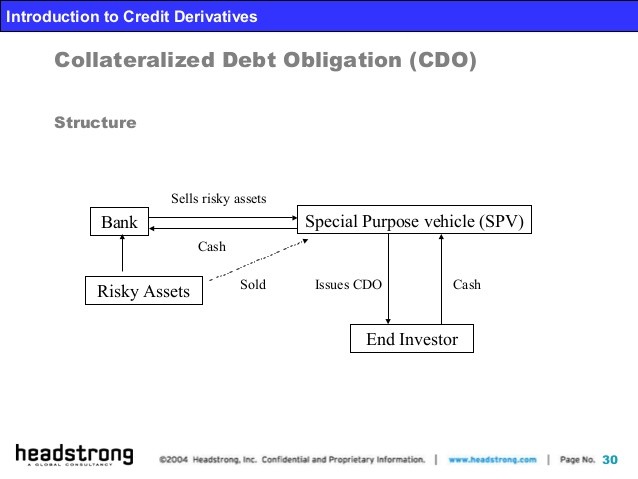AN INTRODUCTION TO COLLATERALISED DEBT OBLIGATIONS
Post on: 10 Апрель, 2015 No Comment

Page 1
AN INTRODUCTION TO COLLATERALISED DEBT OBLIGATIONS
Moorad Choudhry and Aaron Nematnejad
Collateralised Debt Obligations (CDOs)
A CDO is essentially a securitisation in which a special purpose vehicle or SPV issues bonds
or notes against an investment in a diversified pool of assets. These assets can be bonds, loans
such as commercial bank loans or a mixture of both bonds and loans. Where assets are bonds,
these are usually high-yield bonds that provide a spread of interest over the interest liability of
the issued notes; where the assets are loans, the CDO acts as a mechanism by which illiquid
loans can be pooled into a marketable security or securities. The third type of CDO is known
as a synthetic CDO and refers to a structure in which credit derivatives are used to construct
the underlying pool of assets.
The investments are funded through the issue of the notes, and interest and principal payments
on these notes are linked to the performance of the underlying assets. These underlying assets
act as the collateral for the issues notes, hence the name. The key difference between CDOs
and ABS and multi-asset repackaged securities is that the collateral pool is more actively
managed by a portfolio or collateral manager. Generally CDO feature a multi-tranche
structure, with a number of issued securities, most or all of which are rated by a ratings
agency. The priority of payment of the issued securities reflects the credit rating for each note,
with the most senior note being the highest rated. The term waterfall is used to refer to the
order of payments; sufficient underlying cash flows must be generated by the issuing vehicle
in order to meet the fees of third-party servicers and all the note issue liabilities. In Europe
issued securities may pay a fixed or floating coupon, usually on a semi-annual, quarterly or
monthly basis1, with senior notes issues from AAA to A and junior and mezzanine notes rated
BBB to B. There may be unrated subordinated and equity pieces issued. Investors in the
subordinated notes receive coupon after payment of servicing fees and the coupon on senior
notes. The equity and subordinated note are the first loss pieces and, as they carry the highest
risk, have a higher expected return compared to that of the underlying collateral.
There are two types of CDO, collateralised bond obligations (CBOs) and collateralised loan
obligations (CLOs). As the names suggest, the primary difference between each type is the
nature of the underlying assets; a CBO will be collateralised by a portfolio of bonds while a
CLO will represent an underlying pool of bank loans. CDOs have also been collateralised by
credit derivatives and credit-linked notes. Following this distinction, CDOs can be broken into
two main types, balance sheet CDOs and arbitrage CDOs. Balance sheet CDOs are most akin
to a traditional securitisation; they are created to remove assets from the balance sheet of the
originating bank or financial institution, usually for reduce capital requirements, increase
return on capital or free up lending lines. An arbitrage CDO is created when the originator,
who may be a bank or fund manager for instance, wishes to exploit the yield differential
between the underlying assets and the overlying notes. This may be achieved by active
management of the underlying portfolio, which might consist of high-yielding or emerging
market bonds. Arbitrage CDOs are categorized further into cash flow and market value CDOs.
1 Hence proving once and for all that Eurobonds, defined as international securities issued by a syndicate of
banks and clearing in Euroclear and Clearstream, may pay coupon on frequencies other than an annual basis!
Page 2
Almost invariably balance sheet CDOs are cash flow transactions. Put simply a cash flow
CDO is one in which the underlying collateral generates sufficient cash flow to pay the
principal and interest on the issued notes, as well as the servicing fees of third party agents. In
a market value CDO, the collateral manager actively runs the portfolio and, by means of this
trading activity, generates sufficient returns to pay the CDO obligations.
Banks and financial institutions use CDOs to diversify their sources of funding, to manage
portfolio risk and to obtain regulatory capital relief. Investors are attracted to the senior notes
in a transaction because these allow then to earn relatively high yields compared to other
asset-backed bonds of a similar credit rating. Other advantages include:
• exposure to a diversified range of credits;
• access to the fund management and credit analysis skills of the portfolio manager;
• generally, a lower level of uncertainty and risk exposure compared to a single bond of
similar rating.
A good overview introduction to CDOs is given in Fabozzi (2000). We show a “family tree”
of CDOs in figure 7.15. The most common CDOs are balance sheet deals; however a later
development, the synthetic CDO, now accounts for a large number of transactions.














